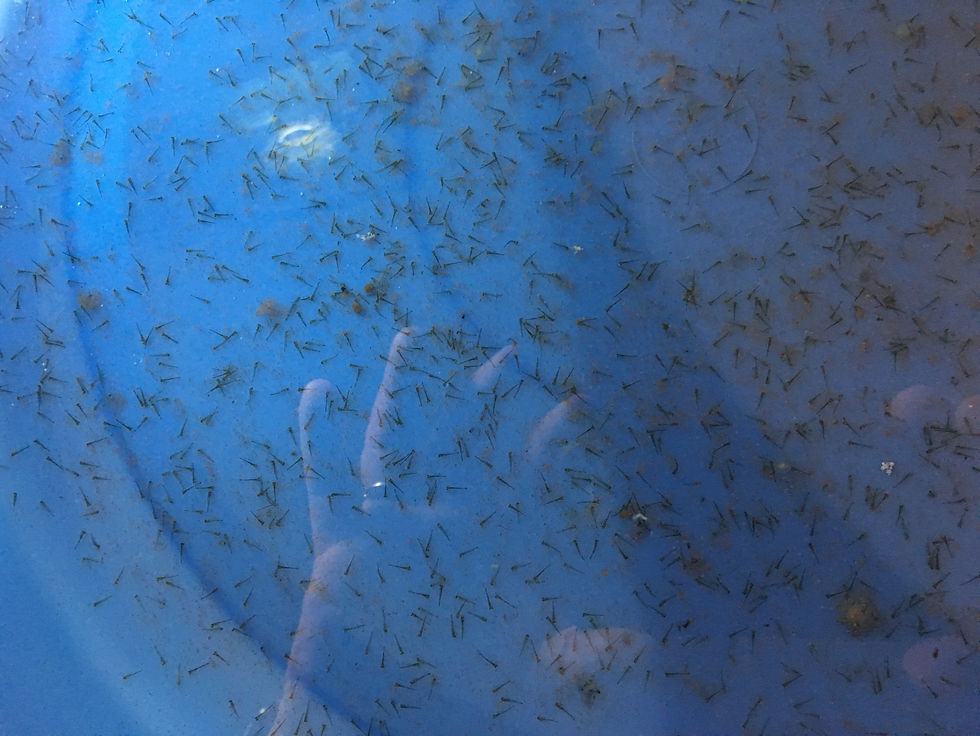Blog 2017 – 10: Food, Floating, Fry, and Future by Gary Hater
- goldfishcouncil
- Apr 13, 2017
- 4 min read

Above, baby Ranchu from my TOKS line that became free swimming on Valentine’s day, after hatching two days earlier. Many people fail to realize, that until the fry are free swimming you feed nothing. Also, at this stage, try never to use a net, they are just too tender.
For many of us, breeding season and fry raising is upon us. For the folks, up North with no indoor hobby the anticipation is ramping up. For me the game begins with seven Ranchu spawns since January 8th. Let the games begin! My Veiltails and Broadtails are moved to larger quarters and the excess fish in larger quarters were sold in a fire sale at the GCAS.org annual Swap Meet here in Cincinnati.
Now the fun begins, Top View Ranchu and perhaps Tosakin are the most demanding of all goldfish to raise. For top view Ranchu; water must be very shallow, typically 4” to 6” deep so the tail angle is maintained near the horizontal plane, water quality must be pristine, and food must be the right size, type, and unlimited. There is a giant push to get to the first cull where improper swimming motion, wrong tail shoulder angles, lack of tail splits, clamped fins, and deformities are removed. For me, this year, the first spawn was culled at day 20. With thousands of fry being fed every day, you should grow them swiftly or risk stunting or disease from overcrowded fry. The features you are selecting for in this first culling are simple, the trick is, the fish must be big enough to see clearly, (the older your eyes get the bigger the fish must be). This year we grew fish that were initially eyelash sized at about 4mm (about 1/8”) to 1 cm (about 3/8’), sometimes 1.2cm (about ½”).

The culls at 20 days, just look at the lead fin ray on the tails (tail shoulder), the tail shoulders are not perpendicular to the peduncle.

The above fry are the keepers, note this is the first cull, tail split is not always obvious at this point (at least for my eyes). Remember with top view Ranchu, go through a minimum of three and sometimes as many as six culls.
Sorry for the reflecting lights in these pictures.
To be successful at getting rapid growth, you must get the right size and the right ingredients. For Ranchu, while the skull is soft and forming, you want the skull to get broad and modified. Shallow water appears to keep the water pressure off the skull allowing for manipulation and deformation (broadening). As for food size and ingredients, first meals are typically 30 -60 microns (u or um). This live food is continued for many weeks, but most start dried prepared supplements immediately. Older and more frugal folks use an electric coffee bean grinder to get small foods by grinding flake and pellet food. For me, I prefer get a range of small foods such as Golden Pearls[1] in 30-60um, 100-200um, and 300-500um. My fry get supplements to live brine shrimp immediately in the tiny range. By fourteen days, they are eating 100-200um diameter food as a supplement and pecking away at chunks of gel food and egg custard (this is a new experiment for me). Just a note, the first cull on top view Ranchu, typically removes 50% of the fry.
For Ranchu, fatty acids omega 3 and 6, and HUFAs (highly unsaturated fatty acids) are critical if you want a wen, early on. Eggs, blood worms, tuna, salmon, and perhaps krill fats are key things for my fish crowd. A more detailed explanation is available by Virginia Tech’s Aquaculture department (link). https://pubs.ext.vt.edu/420/420-256/420-456.html
Pushing the size of the food, to get great and fast growth is critical to me, but what about everybody else? In the aquaculture industry fish food size is matched by fish size and weight. Commercial aquaculturists track fish size and weight to determine the amount of food and the size. In general, the size of the food item should be 20%-30% of the size of the open mouth, https://pubs.ext.vt.edu/420/420-256/420-456.html. Food that is too small results in the fish spending too much time looking and chewing. This results in the fry using up too much energy and grow slow. While food that is too big in diameter results in slowed growth because it cannot be ingested quick enough and it must soften.
In the fry world, excess protein is desired to get rapid growth. Carbohydrates are typically not used in small fish. Large fish typically require and use less protein and fat. The above-mentioned article reviews this statement and has a pretty nice bibliography.
Pellet Size for youngsters and adult goldfish is very important. Here are some thoughts on pellets for goldfish.
At 3/8”/ 1.2cm goldfish are fed on 100-200um feed (0.1 -0.2mm pellet).
At ½” /1.25cm goldfish should be eating 0.5mm feed and slowly upgrade to #3 crumbles and) 0.8mm pellets
At 1” / 2.54cm goldfish should be pushed to go from 0.5mm to 1.0 mm in diameter. Know your food, some pellets marked 1.5mm are really 1.0 mm.
A 1.5 mm pellet is generally the maximum diameter I recommend, unless big fish are in with koi.
Sinking pellets should always be used indoors. Floating pellets with less protein are OK for outdoor summer use. Indoors floating pellets promote floating.
All food should be refrigerated, not frozen until used.
Hope you all enjoy the food, next some experiments with eggs!
Gary
Golden Pearls is a trade name of prepared food for small fish, available at BrineShrimpDirect.com and Kensfsih.com, Note TGC does not endorse vendors as a written By Law Policy, this is simply source information.. ↑



Comments